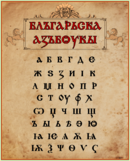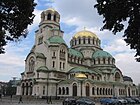National symbols of Bulgaria
This articleneeds additional citations forverification.(October 2013) |
Thenational symbols of Bulgariaare thesymbolsthat representBulgariaand theBulgarian people.
Official symbols
[edit]| Type | Image | Symbol |
|---|---|---|
| National flag | 
|
Flag of Bulgaria
TheflagofBulgaria(Bulgarian:знаме на България,romanized:Zname na Bǎlgarija,[ˈznamɛnɐbɐɫˈɡarijɐ]) is atricolourconsisting of three equal-sized horizontal bands of (from top to bottom)white,green,andred.It was first adopted after theRusso-Turkish War (1877–1878),where Bulgaria regained independence. At times, the national flag was charged with the state emblem, especially during thePeople's Republic of Bulgaria.The current flag was re-established with the 1991Constitution of Bulgariaand was confirmed in a 1998 law. |
| Coat of arms | 
|
Coat of arms of Bulgaria Thecoat of arms ofBulgaria(Bulgarian:Герб на България,[ˈɡɛrpnɐbɐɫˈɡarijɐ]) consists of a crowned goldenlion rampantover a dark redshield;above the shield is the Bulgarian historicalcrown.The shield issupportedby two crowned golden lions rampant; below the shield there iscompartmentin the shape ofoaktwigs and white bands with the nationalmotto"Unity makes strength" inscribed on them. |
| National anthem | Mila Rodino
"Mila Rodino"("Мила Родино"[ˈmiɫɐˈrɔdino],translated as "Dear Motherland" or "Dear native land" ) is the currentnational anthemofBulgaria.It is based on the music and text of the song"Gorda Stara Planina"byTsvetan Radoslavov,written and composed as he left to fight in theSerbo-Bulgarian Warin 1885. The anthem was adopted in 1964. The text has been changed many times, most recently in 1990. |
Other symbols
[edit]| Type | Image | Symbol |
|---|---|---|
| Cyrillic alphabet | 
|
TheCyrillic script/sɪˈrɪlɪk/is an alphabeticwriting systememployed acrossEastern EuropeandnorthandcentralAsia. It is based on theEarly Cyrillic,which was developed during theFirst Bulgarian Empirein the 9th century AD at thePreslav Literary School.[1][2][3]
With theaccession of Bulgaria to the European Unionon 1 January 2007, Cyrillic became the third official script of theEuropean Union,following theLatin scriptandGreek script.[4] |
| Lion (heraldry) | 
|
The earliest example of a lion's image as theheraldic symbolof Bulgaria is documented in theLord Marshal's Roll,[5]composed around 1294 AD and preserved in a copy from about 1640. In its first part under No.15 is represented the coat of arms ofLe Rey de Bugrieor the King of Bulgaria, most probably this ofTsar Smilets(1292–1298) or may be some of his recent predecessors. It consists of an argent lion rampant with golden crown over sable shield. In the end of the 14th century an anonymous Arab traveller, who visited the capital of the Second Bulgarian EmpireTarnovo,saw and depicted three lions guardant passant gules painted on the round golden shields carried by the personal guards ofTsar Ivan Shishman(1371–1395). His manuscript is now kept in the National Library of Morocco.[6] |
| National hero | 
|
Vasil Levski[7](Bulgarian:Васил Левски,originally spelled Василъ Лѣвскій,[8]pronounced[vɐˈsiɫˈlɛfski]), born Vasil Ivanov Kunchev[9](Васил Иванов Кунчев; 18 July 1837 – 18 February 1873), was a Bulgarianrevolutionaryand is a national hero ofBulgaria.Dubbed theApostle of Freedom,Levski ideologised and strategised a revolutionary movement toliberate BulgariafromOttomanrule. Founding theInternal Revolutionary Organisation,Levski sought to foment a nationwide uprising through a network of secret regional committees. |
| Patron saint | 
|
Saint John of Rila(Bulgarian:Свети Йоан (Иван) Рилски,sveti Ioan Rilski) (876 – c. 946) was the firstBulgarianhermit. He was revered as a saint while he was still alive. The legend surrounding him tells of wild animals that freely came up to him and birds that landed in his hands. His followers founded many churches in his honor, including the famousRila Monastery.One of these churches, "St Ivan Rilski" was only discovered in 2008 in the town of Veliko Tarnovo. Today, he is honored as the patron saint of theBulgariansand as one of the most important saints in theBulgarian Orthodox Church. |
| Folk dances(Horo) | 
|
TheBulgarian dances(Horo) (Bulgarian:Хоро), are intimately related to themusic of Bulgaria.This distinctive feature ofBalkanfolk musicis the asymmetricalmeter,built up around various combinations of 'quick' and 'slow'beats.The music, in Westernmusical notation,is often described usingcompound meternotation, where the notational meter accents, i.e., the heard beats, can be of different lengths, usually 1, 2, 3 or 4. |
| National drink | 
|
Rakia(Fruit brandy) is the national drink of Bulgaria. Currently, there is no defined origin of rakia but there are many who claim to be the origins of the drink, most vocally Bulgaria.
A recent discovery by a team of archaeologists led by Philip Petrunov discovered near the fortress "Lyutitsa" (inIvaylovgrad) fragment of the distillation container for the production of rakia. According to experts discovery dates back to the 11th century AD and this proves that rakia is produced and consumed inBulgariain the 11th century AD. UnknownBulgariannobleman fromVeliko Tarnovo,in the 14th century wrote on a glass that drinking rakia during the Church Holiday. In support of that rakia inBulgariawas known before the invasion of the Ottomans is justification of the Turkish commanderLala Sahinto the Ottoman sultan that in 1382 failed to conquerSofia,because "the defense of the city was entrusted to strong, healthyBulgarians"with mustaches" that before battle drank rakia and so became invincible ". |
| National monument(s) | 
|
TheMadara RiderorMadara Horseman(Bulgarian:Мадарски конник,Madarski konnik) is anearly medievallarge rockreliefcarved on the Madara Plateau east ofShumenin northeasternBulgaria,near the village ofMadara.The monument is dated in the very late 7th,[10]or more often very early 8th century, during the reign ofBulgarianKhanTervel.[10][11]In 1979 became enlisted on theUNESCOWorld Heritage List. |

|
TheSt. Alexander NevskyCathedral (Bulgarian:Храм-паметник „Свети Александър Невски “,Hram-pametnik „Sveti Aleksandar Nevski “) is aBulgarian Orthodoxcathedral inSofia,the capital ofBulgaria.Built inNeo-Byzantine style,it serves as the cathedral church of thePatriarch of Bulgariaand is one of the largest Eastern Orthodox cathedrals in the world, as well as one of Sofia's symbols and primary tourist attractions.[12][13]
The St. Alexander Nevsky Cathedral in Sofia occupies an area of 3,170 square metres (34,100 sq ft) and can hold 10,000 people inside.[12] | |

|
TheMonastery of Saint Ivan of Rila,better known as theRila Monastery(Bulgarian:Рилски манастир,Rilski manastir) is the largest and most famousEastern Orthodoxmonastery inBulgaria.It is situated in the southwesternRila Mountains,117 km (73 mi) south of the capitalSofiain the deep valley of theRilska Riverat an elevation of 1,147 m (3,763 ft) above sea level, inside ofRila Monastery Nature Park.The monastery is named after its founder, the hermitIvan of Rila(876 - 946 AD). | |
| Adornment | 
|
AMartenitsa(Bulgarian:мартеница,pronounced[ˈmartɛnit͡sa]) is a small piece of adornment, made of white and red yarn and usually in the form of two dolls, a male and a female. Martenitsi are worn fromBaba Marta Day(1 March) until the wearer first sees a stork, swallow, or budding tree (or until late March). The name of the holiday means "Grandma March" in Bulgarian and the holiday and the wearing of Martenitsi are aBulgariantradition related to welcoming the spring, which according to Bulgarian folklore begins in March.[14] |
| National instrument | 
|
Thekaba gaidais aBulgarianmusicalbagpipeinstrument similar to thegaida.It is larger and lowerpitchedthan the typical gaida. It is native to theRhodope Mountainsof Bulgaria.
Nowadays the most commondronetone on a kaba gaida is E. |
See also
[edit]References
[edit]- ^Dvornik, Francis (1956).The Slavs: Their Early History and Civilization.Boston: American Academy of Arts and Sciences. p. 179.
The Psalter and the Book of Prophets were adapted or "modernized" with special regard to their use in Bulgarian churches, and it was in this school that glagolitic writing was replaced by the so-called Cyrillic writing, which was more akin to the Greek uncial, simplified matters considerably and is still used by the Orthodox Slavs.
- ^Southeastern Europe in the Middle Ages, 500–1250, Cambridge Medieval Textbooks, Florin Curta, Cambridge University Press, 2006,ISBN0521815398,pp. 221–222.
- ^The Orthodox Church in the Byzantine Empire, Oxford History of the Christian Church, J. M. Hussey, Andrew Louth, Oxford University Press, 2010,ISBN0191614882,p. 100.
- ^Orban, Leonard (24 May 2007)."Cyrillic, the third official alphabet of the EU, was created by a truly multilingual European"(PDF).europe.eu.Retrieved3 August2014.
- ^"The Lord Marshal's Roll, Part I".Brian Timms' Studies in Heraldry. Archived fromthe originalon 9 November 2006.Retrieved1 January2007.
- ^Voynikov, Ivan."Chapter II".History of the Bulgarian State Symbols(in Bulgarian).
- ^First name alsotransliteratedasVassil,nickname archaically written asLevskyin English (cf. MacDermott).
- ^Унджиев 1980,p. 53
- ^Family name also transliterated asKunčev,Kountchev,Kuntchev,etc.
- ^abPetkov, Kiril (2008).The Voices of Medieval Bulgaria, Seventh-Fifteenth Century: The Records of a Bygone Culture.Brill. pp. 5, 11.ISBN9789004168312.
- ^Sophoulis, Panos (2011).Byzantium and Bulgaria, 775-831.Brill. pp. 83–85.ISBN9789004206960.
- ^ab "Sofia, Bulgaria", Mihail Dyuzev, Hitotoki.org, 2010, web: Hito-4Archived2010-03-30 at theWayback Machine.
- ^ "Neo-Byzantine architecture |archipaedia.net", archipaedia.net, 2010, web: A7.
- ^"Customs and rituals: Grandmother March, Baba Marta, 1st March, Martenica".Regional Historical Museum Burgas.Retrieved15 March2019.

